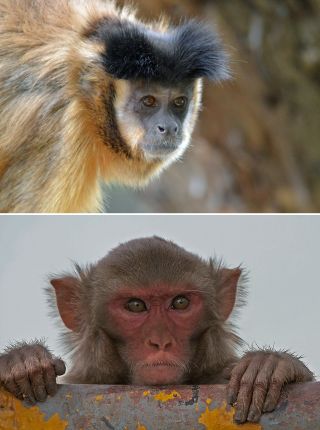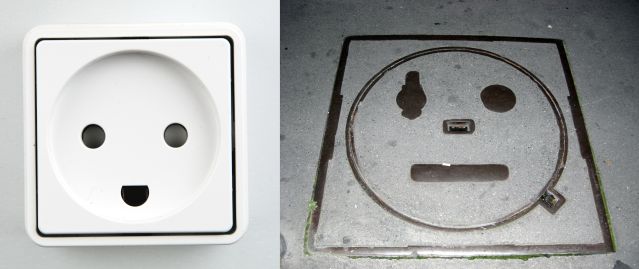Animal Behavior
Are Humans Unique in Seeing Faces Everywhere?
Humans, but not monkeys, are susceptible to the face pareidolia illusion.
Posted June 22, 2023 Reviewed by Gary Drevitch
Key points
- Face pareidolia is a common visual illusion in which one misperceives a face in an inanimate object.
- In a test, preschool-aged children appeared to experience face pareidolia, while two kinds of monkeys did not.
- Humans may be more susceptible to face pareidolia due to their preferential processing of global patterns.
- Monkeys may not experience face pareidolia because they tend to rely more on local, individual features.

Whether or not you’ve ever heard the term face pareidolia, you’ve almost certainly experienced it. Face pareidolia is an illusion that involves perceiving a face when one is not there, such as in a pattern of clouds or the scorch marks on a piece of toast. It’s a common feature of the human face-detection system and a near-universal human experience. But do other species also perceive this illusion? Although there are many similarities in how humans and nonhuman primates perceive and respond to actual faces, it’s not clear whether species such as monkeys perceive illusory faces.
A Matter of Perception
To investigate this question, researchers at Georgia State University presented a computerized face categorization task to capuchin monkeys, rhesus monkeys, and preschool-aged children. First, the subjects were given pairs of images, one containing a face and one a nonface image, and were trained to select the image with the face. Once they understood the rule, the test trials started. These included images of actual faces, illusory (pareidolia) faces, nonface objects, and images of real faces with the features scrambled.
“We were asking them to tell us—even if an actual face isn’t present—which image is more face-like,” says Molly Flessert, who conducted the study for her Master’s thesis.
“I predicted that children and the two species of monkeys would select the illusory faces as more face-like. But that is not what we found.”
Children and monkeys chose actual faces when they saw them, and selected them over illusory faces, demonstrating that they understood the task.
However, only children selected illusory faces at levels above chance. “Children chose a face when a face was there,” says Flessert. “And when a face wasn’t there, they chose an illusory face.”
The monkeys also chose a face if a face was presented but did not seem to treat the illusory face images as more face-like than objects or scrambled faces. In fact, if given the choice between an illusory face and a scrambled face, monkeys usually chose the scrambled face.
Making Faces
The results suggest that while children report perceiving face pareidolia, monkeys do not.
One explanation for this species difference involves how humans and monkeys process visual information. Humans tend to process stimuli on a global level, perceiving things as the sum of their parts rather than just the individual, or local, features.
Monkeys, on the other hand, appear to rely more on local processing, says psychologist Michael Beran, senior author of the study. “Monkeys see the trees, not the forest,” he says.
The finding that monkeys chose scrambled faces over illusory faces may indicate that they perceive images containing the local features of a face (although out of place) as more “face-like” than images that contain only a face-like configuration (but no actual facial features).
“It suggests that at least these species of monkeys, and likely other monkeys, attend to the local features of stimuli and make decisions based on those, and it is more difficult for them to see and respond to the holistic, global attributes of stimuli,” says Beran.
The results fit in nicely with another recent study showing that chimpanzees may fall between monkeys and people in the way they perceive illusory faces. Altogether, the literature suggests an evolutionary continuum in primates’ propensity to experience face pareidolia, from monkeys that do not perceive illusory faces as particularly face-like, to humans who can’t help but see illusory faces.

Cognitive Resources
Beran says that different species’ preference for local versus global processing may be tied to their attention systems. In humans, the attention system is under heavy cognitive control. This helps us focus on the most relevant information while avoiding distracting information, and allows us to read, study, and follow conversations, among other cognitively sophisticated tasks.
For monkeys, the most important visual processing task they encounter may be deciding if someone is a friend or foe or potential predator. This can be achieved by learning and memorizing features and then scanning visually for those features. It does not require the same computational power.
“Humans have the prefrontal cortex and executive resources to prioritize global information,” says Beran. “At the same time, we have secondary systems that may be less accessible to immediate consciousness that are encoding the local details. That is going on in the background even as your conscious awareness is of the global picture.”
As a result, humans have the ability to process the big picture, as well as to direct their attention to individual details. But this preference for global processing, along with our sensitivity to faces as stimuli, leads to perceiving faces when they’re not there. Monkeys, possessing less computational power, rely more on local features, rather than holistic patterns. For them, it’s the individual facial features that make something a face.
So the next time you see a face in a parking meter or a wallpaper pattern, thank your brain for this very human illusion.
References
Flessert M, Taubert J, Beran MJ. Assessing the perception of face pareidolia in children (Homo sapiens), rhesus monkeys (Macaca mulatta), and capuchin monkeys (Sapajus apella). J Comp Psychol. 2023 May;137(2):90-101. doi: 10.1037/com0000320.
Tomonaga M, Kawakami F. Do chimpanzees see a face on Mars? A search for face pareidolia in chimpanzees. Anim Cogn. 2023 Jun;26(3):885-905. doi: 10.1007/s10071-022-01739-w.




